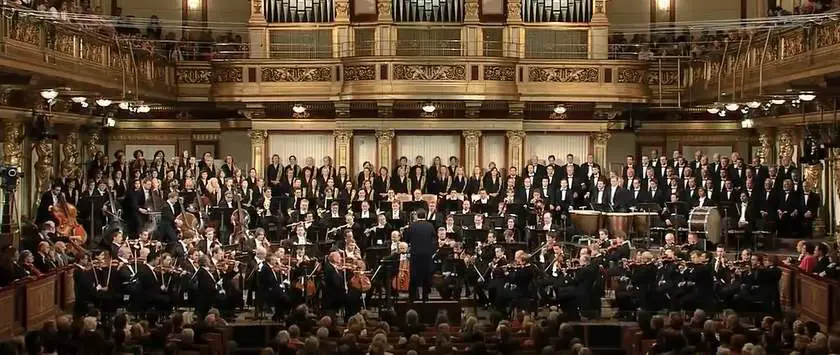Conducted by Jordi Savall, Le Concert des Nations, and Vox Bona Chamber Choir perform Ludwig van Beethoven’s Symphony No. 9 in D minor, Op. 125 with period instruments. With the final chorus based on Friedrich Schiller’s poem “An die Freude”, Beethoven’s 9th symphony is regarded by many critics and musicologists as the composer’s greatest work and one of the supreme achievements in the history of music. This performance was the opening concert of the Beethovenfest Bonn 2021, from the World Conference Center Bonn (WCCB), on August 20, 2021.
Le Concert des Nations is an orchestra with period instruments, able to perform the orchestral and symphonic repertoire from the Baroque to Romanticism (from 1600 to 1900). The orchestra was created in 1989, the youngest of the groups conducted by the Catalan maestro and viola da gamba virtuoso Jordi Savall.
In this performance, Beethoven’s Symphony No. 9 can suddenly appear so distinctly different and indeed new due not least to the revised musical score. The musicians are also playing the scholarly complete edition, published in 2020 by Dr. Beate Angelika Kraus. This is the German premiere of this version of Beethoven’s Ninth.
The result is an acoustic sensation: in this spectacular opening concert of the 2021 Beethovenfest in Bonn, Germany, Jordi Savall, and his musicians succeed in creating an extraordinary interpretation of the universally recognizable work.
The Le Concert des Nations orchestra – renowned for its historical performance practice – strips Beethoven’s Symphony No. 9 of any monumentality, instead infusing the well-known Beethoven symphony with transparency and lightness that render it a delicate gem.
Even the final movement – with its otherwise deeply laden material – is woven through by the vocal soloists and the VOX BONA Chamber Choir of the Kreuzkirche Bonn to reveal the old masterpiece anew; resplendent in fresh musical garb.
Soloists:
- Sara Gouzy – soprano
- Laila Salome Fischer – mezzo-soprano
- Martin Platz – tenor
- Manuel Walser – baritone

Beethoven’s Symphony No. 9
Simply known as the “choral”, the symphony was composed between 1822 and 1824 and was first performed in Vienna on 7 May 1824.
Movements (with the starting times in the video:
- (00:00) I. Allegro ma non troppo, un poco maestoso. The first movement is in sonata form without an exposition repeat. It begins with open fifths (A and E) played pianissimo by tremolo strings, steadily building up until the first main theme in D minor at bar 17. The opening, with its perfect fifth quietly emerging, resembles the sound of an orchestra tuning up. At the outset of the recapitulation (which repeats the main melodic themes) in bar 301, the theme returns, this time played fortissimo and in D major, rather than D minor. The movement ends with a massive coda that takes up nearly a quarter of the movement, as in Beethoven’s 3rd (Eroica) and 5th Symphonies.
- (15:15) II. Molto vivace. The second movement is a scherzo and trio. Like the first movement, the scherzo is in D minor. Normally, a scherzo is in triple time. Beethoven wrote this piece in triple time but punctuated it in a way that, when coupled with the tempo, makes it sound as if it is in quadruple time. For the second subject, it modulates to the unusual key of C major. The exposition then repeats before a short development section, where Beethoven explores other ideas. The recapitulation (repeating of the melodic themes heard in the opening of the movement) further develops the exposition’s themes, also containing timpani solos. A new development section leads to the repeat of the recapitulation, and the scherzo concludes with a brief codetta. The contrasting trio section is in D major and in duple time. The trio is the first time the trombones play. Following the trio, the second occurrence of the scherzo, unlike the first, plays through without any repetition, after which there is a brief reprise of the trio, and the movement ends with an abrupt coda.
- (30:55) III. Adagio molto e cantabile. The third movement is a lyrical, slow movement in B-bemol major-a minor sixth away from the symphony’s main key of D minor. It is in a double variation form, with each pair of variations progressively elaborating the rhythm and melodic ideas. The first variation, like the theme, is in 4/4 time, the second in 12/8. The variations are separated by passages in 3/4, the first in D major, the second in G major, the third in E♭ major, and the fourth in B major. The final variation is twice interrupted by episodes in which loud fanfares from the full orchestra are answered by octaves by the first violins. A prominent French horn solo is assigned to the fourth player.
- (42:48) IV. Presto. Finale. The choral finale of Symphony No. 9 is Beethoven’s musical representation of universal brotherhood based on the “Ode to Joy” theme and is in theme and variations form. The movement starts with an introduction in which musical material from each of the preceding three movements-though none are literal quotations of previous music-are successively presented and then dismissed by instrumental recitatives played by the low strings. Following this, the “Ode to Joy” theme is finally introduced by the cellos and double basses. After three instrumental variations on this theme, the human voice is presented for the first time in the symphony by the baritone soloist, who sings words written by Beethoven himself: ”O Freunde, nicht diese Töne!’ Sondern laßt uns angenehmere anstimmen, und freudenvollere.” (“Oh friends, not these sounds! Let us instead strike up more pleasing and more joyful ones!”).
Sources
- Symphony No. 9 (Beethoven) on Wikipedia
- Le Concert des Nations on Wikipedia
- Pavarotti sings Pourquoi me réveiller [Massenet] at the Central Park in 1993 - April 23, 2024
- Elgar: Serenade for Strings [Concertgebouw Chamber Orchestra] - April 19, 2024
- Mozart: Serenade No. 10 “Gran Partita” [MET Orchestra Chamber Ensemble] - April 18, 2024


